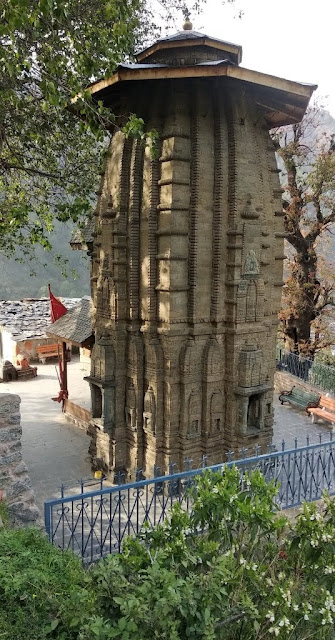Vajreshwari Temple, Chamba –
The Temple
This temple is facing towards west. The temple consists of sanctum, an entrance porch and a wooden mandapa. The entrance porch has two pillars with square bases and cylindrical shaft topped by square capitals. The lintel above the capitals show Durga seated on lion. She is four armed holding a khadga, trisula, khetaka and patra. The pediment like other temples shows bhadramukhas. The rest of the facade is decorated with reduplicated sikhara shrines in relief.
The wooden mandapa seems to be a nineteenth century addition. The sanctum is square on plan. The doorjambs of the sanctum doorway has three bands of decoration. The sanctum enshrines an image of Vajreshwari. Lord Vishnu with three faces is placed beside her. Among the three faces, one is of a human, the other is of a boar and the third is of a lion. The shikara over the sanctum is of nine tiers. It is surmounted by an umbrella canopy, amalaka. kalasa and trisula.
The exterior wall has three bhadra niches on the south, east and north enshrining an unidentified image in the southern niche while eastern and northern niches enshrines the images of Mahisasura Mardini. The inside of the kapili walls has been carved elaborately. The scones from top to bottom on the right walls are ghatapallava, two musicians, Surya seated on three horses, two elephants and Mahakala standing on a prostrate female.
He is four-armed holding kapala & khadga in his right hands and naga & patra in his left hands. The scones from top to bottom on the right walls are ghatapallava, two dancers and a three-headed Shiva seated on Nandi. He is four armed holding a trisula & akshamala in his right hands, lower right hand holds a pot and lower left hand is broken. The lowermost idol in this wall might be Mahakala.
There is also a drum house or Nagarkhana at the entrance and two lion sculptures are placed as a symbol for protection. The temple walls and pillars contain eighteen label inscriptions recording the names of nine artisans including a blacksmith, two carpenters, the supervisor named Marachu and the mason Jemala. All these artisans were employed by King Udai Singh (1690 – 1720 CE) for the renovation of the temple.
.jpg)


.jpg)

.jpg)




No comments:
Post a Comment